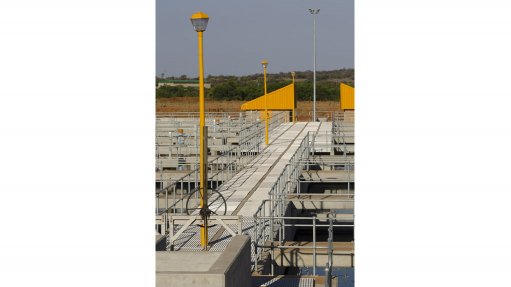
Mentis manufactures a range of corrosion-resistant floor grating and handrailing solutions, ideal for use in the wastewater industry. These include mild steel galvanised, 304 stainless steel, 3CR12 stainless steel and fibreglass options; all ideally suited to the extreme conditions in wastewater facilities.
The presence of air-borne hydrogen sulphide (H2S) can cause severe corrosion in wastewater treatment plants, which means the correct material must be selected for key infrastructure.
Wastewater can become anaerobic or septic as it travels through sewer lines, due to metabolic processes in microbes it contains. When dissolved oxygen becomes depleted in this way, certain sulphate-reducing bacteria thrive and produce the corrosive H2S.
Among the most common infrastructure elements in wastewater plants are floor grating and handrailing, which Mentis, previously known as Andrew Mentis, manufactures in a range of corrosion-resistant materials. These include mild steel galvanised, 304 stainless steel, 3CR12 stainless steel and fibreglass options; all ideally suited to the extreme conditions in wastewater facilities.
Lance Quinlan, national technical sales consultant at Mentis, notes that safety is a primary concern in these facilities, especially where there may be toxic conditions within wastewater conveyance and treatment facilities.
“These products are designed and engineered to suit situations like these, where the strength to weight ratio is important,” Quinlan says. Mentis Rectagrid RS40 40/40 floor grating, for example, is engineered with a pressure locking system that guarantees the structural integrity of the product.
Quinlan points out that the transversals on the floor grating are permanently locked to the bearer bars. The locking method at the intersections is designed to use the full depth of the bearer bar when calculating loads.
“Load-bearing capacity is prioritised in the design and manufacturing of these products,” he says.
Another safety issue is created by the mechanical and chemical processes to remove pollutants from wastewater. Quinlan highlights that vapours, water and chemicals can create slick underfoot and handhold conditions for operators and technicians. Moreover, this hazard can occur near large machinery and tanks. This creates a considerable safety risk where handrailings and floor gratings are weakened by corrosion and damp.
“Apart from the danger of slips, trips and falls, every operation that has to replace these items will incur downtime, which in turn reduces productivity,” he says.
In addition to using corrosion-resistant material, the stainless steel tubular handrailing systems from Mentis have been designed so that moisture drains from the stanchion itself. This adds to their durability and resilience. Galvanised stanchions measure 42,8 mm diameter by 2,5 mm wall thickness. The 3CR12 or 304 stainless steel options – polished to a satin finish – are 44,5 mm diameter and 2 mm wall thickness.
The tubular handrailing system is also rendered more versatile by its standard angles and matching accessories – such as bends and end-closers.
Ease of installation is also enhanced, as the system fits together as interlinking components; this means that installation can be done without special tools.
Quinlan stresses the importance of giving individual attention to each wastewater application before products are specified.
“Working to meet specific application requirements within the customer’s deadlines, we are then able to customise the right products for the task,” he says. “This principle has led to Mentis Rectagrid and Mentis handrailing being selected for numerous wastewater treatment plants in the industry.”
At the same time as delivering a functional and cost effective solution, these mild steel galvanised, stainless steel and fibreglass solutions also add to the aesthetics of the plant.